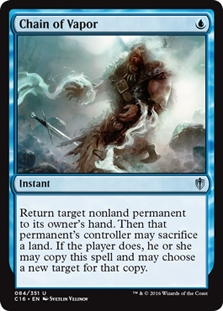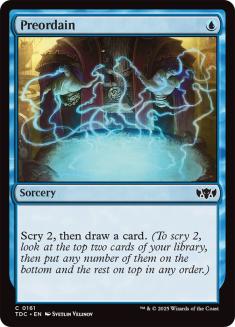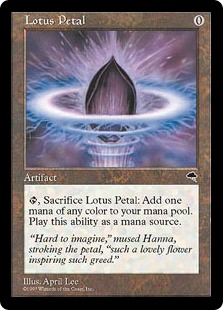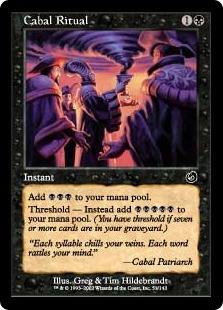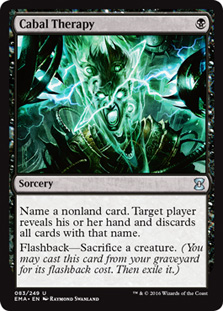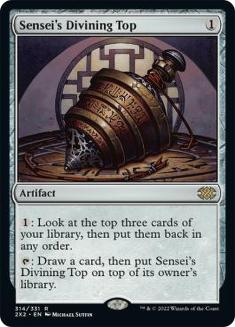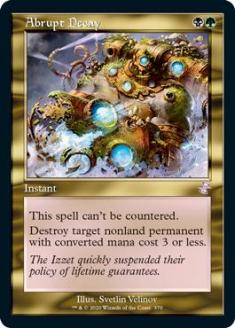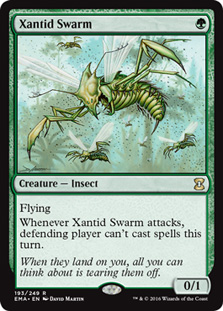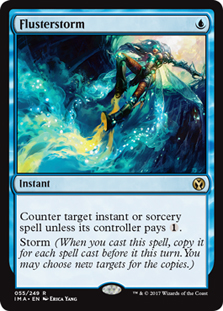Whenever I write about Storm – such as my Prague Eternal report from earlier this month – there is
a phenomenon I’ve never encountered with any other deck: I suddenly get forum PMs, facebook messages, and comments that ask questions about the deck and
how to play it. I’m always happy to get those questions – and try to answer them in a reasonably timely manner – because not only do I enjoy talking to you
guys, but it also shows that there are a number of players out there who actually get what the deck is about: playing flawlessly.
As you’re all aware, I believe that Storm is one of the most undervalued decks in all of Legacy. For how powerful and consistent the deck is, there’s
really no excuse for how few people are actually playing it – the complexity level aside. Storm games are simply so decision laden and the deck is so
unforgiving that it is very hard to not lose at least a couple of games every tournament to your own mistakes. So working on minimizing your mistakes and
perfecting everything that’s based on preparation in your play before taking the beast to any event is actually significantly more important than having
the card for card perfect list.
The most common questions I get – and the most grievous mistakes I usually see – from aspiring Storm players concern one area in particular: sideboarding.
That shouldn’t be a surprise. Storm is so different from the rest of Magic that it is hard to just transfer knowledge and experience from other decks
you’ve played. So today, instead of going over these questions again and again for each player individually, I’ll try to outline how sideboarding works
with Storm in a general sense.
By the way, this approach should be quite helpful when playing just about any combo deck. However, it works better the closer your combo finish is to
actually straight up ending the game. Something like Show and Tell for Griselbrand or casting Splinter Twin on Deceiver Exarch has a lot more holes after
you’ve gotten to a position that looks like it should win – Phyrexian Revoker/Karakas and Abrupt Decay/other instant speed removal, respectively, to give
you examples – than just making a bunch of mana before removing their life total by casting a single card.
A Quick Refresher
For reference, this is the ANT list I’m currently playing:
Lands (15)
Spells (45)
- 1 Sensei's Divining Top
- 1 Tendrils of Agony
- 4 Brainstorm
- 4 Cabal Ritual
- 3 Duress
- 4 Dark Ritual
- 1 Grim Tutor
- 3 Cabal Therapy
- 4 Lotus Petal
- 4 Lion's Eye Diamond
- 4 Infernal Tutor
- 4 Ponder
- 1 Ad Nauseam
- 2 Preordain
- 4 Gitaxian Probe
- 1 Past in Flames
Sideboard

The Empty the Warrens occupies essentially a flex slot in the sideboard that could be filled with a variety of tools depending on your comfort level with
certain cards and metagame considerations. However, we aren’t here to talk about my specific list today, so we’ll stop that discussion here. Draw your own
conclusions about what the sideboard as a whole should look like after reading the rest of the article.
In
You might have realized that a lot of successful Storm players have a tendency to sound very full of themselves and their deck. Heck, I usually feel like I
sound cockier in my Storm articles than in just about anything else I write. This is no coincidence. For one, playing with Storm often feels ridiculously
overpowered. Even more importantly though, the attitude is actively helpful in winning with the deck because it helps with intuitively making correct
choices during both gameplay and sideboarding.
To correctly sideboard with Storm, the most important thing to understand is this little philosophical tidbit: If you’re playing Storm in Legacy, you need
to believe that what your deck does is better than what their deck does. That’s the fundamental concept behind everything you do between games.
Now, don’t get me wrong: you aren’t supposed to believe there aren’t any bad matchups or that there is no way you can lose. Instead, the idea is that if
you are allowed to enact your gameplan*, you’re the one who’s going to end up winning.
*FYI: the typical storm gameplan is easily summarized as a “DDD” deck that’s a little different from Dredge: Dig, Disrupt, Dead. What this means is that
you set up with cantrips for as long as necessary, clear the way with disruption, and then win. The first two steps are optional, however, depending on
your opponent and your own hand, which is why Gitaxian Probe is so insane in the deck as it allows you to know without investing either mana or cards.
This inescapably leads to the following conclusion: You don’t actually want to sideboard at all. Assuming your deck is built correctly, your game
1 configuration is the list that most consistently executes your own gameplan – otherwise your maindeck should already look like whatever you’ve changed
during sideboarding, after all. Understanding this turns sideboarding from a very hard thing into something far more managable.
Luckily – otherwise playing Storm would be rather boring – most of your opponents won’t actually allow you to execute your gameplan in peace. They’re going
to try to use a multitude of different angles to keep you from doing so because, as we’ve established above, the assumption is that otherwise you’re going
to win. As a result, your own sideboarding should follow a relatively clear pattern of trying to enforce your ability to play the game while messing as little as possible with your deck in the process. One of the big things that make Storm such a scary deck is how adaptive your
gameplan is. Between all the library manipulation and the multitude of lines that lead to a kill, many problems can be answered simply by adjusting your
play instead of your deck.
The whole sideboarding process then starts with the question: “How do they keep me from executing my gameplan?” Once you’ve answered that, the cards you
actually want to bring in become quite easy to identify.
Here are the main relevant answers:
Countermagic:
This is the most common form of effective interaction and as such your maindeck should already be configured to fight on this axis in most cases. Either
shuffle in fifteen and take them back out or slightly increase your disruption count postboard to compensate for their own sideboarding. If they are
unlikely to kill small creatures in time, you can raise the power level of your gameplan by upgrading discard into Xantid Swarms.
Discard:
The second common form of generic interaction you’re likely to see. Once again, your maindeck should already be configured quite well to survive an attack
on your hand so sideboarding should be minimal to nonexistent (a second Sensei’s Divining Top is pretty neat here).
Mana Denial:
Typically that means Wasteland and Stifle. Mana denial is particularly effective – if combined with some four-of disruption that actually keeps you from
killing them – as it hinders your ability to actually execute your gameplan in a timely fashion instead of just messing with your potential to go off.
However, the game plan is common enough that your maindeck should be reasonably well configured against it (mainly by having a ton of cantrips, basic
lands, and one more land than the deck actually needs to play), though you might want a little extra help against Stifle (which Flusterstorm is excellent
for – and so would be another land in the sideboard).
Disruptive permanents:
These come in two forms: things that keep you from killing them (Meddling Mage on Tendrils of Agony, Leyline of Sanctity in a deck without countermagic)
and things that keep you from setting up and from going off (Chalice of the Void, Counterbalance, Gaddok Teeg, as well as both Thalia, Guardian of
Thraben and Leyline of Sanctity from a deck with countermagic to a certain degree).
Against the former, you really only need one or two ways to get rid of their hate once you’ve already gone off. After all, they allow you to execute your
gameplan to your heart’s content, and as a result Ad Nauseam and Past in Flames generally give you enough options to find your answer once you’re at that
point; this means you can afford to dilute your deck as little as possible.
Against the latter, on the other hand, you need a plan that allows you to answer the hate permanent as soon as possible – or turn it into something that
just keeps you from killing them (the reason Xantid Swarm is awesome against Leyline of Sanctity from blue decks) – because if you can’t dig and combo,
they have actually taken away your inherent advantage of doing something better than they were trying to do.
Racing (aka killing you before you can enact your gameplan):
This typically comes in one of three forms: an actual damage race where they try to deal incremental damage to win first, doing something broken but not
lethal (usually happens in the form of putting a Griselbrand into play to draw a bunch of countermagic currently), or doing something broken and lethal (as
in being a faster combo deck such as Belcher or the Storm mirror).
The incremental damage race is easy to deal with. There isn’t any aggressive deck that can actually straight up race you in even close to a majority of
games. Consider what hate they could have to slow you down, and board according to where that falls in the categories above.
Against Griselbrand, the best course of action is to either stop them from getting to that point, thereby enabling you to put your gameplan into action as
usual, or to make it so that their broken play actually can’t stop you from executing your gameplan (usually thanks to Xantid Swarm).
Finally, against other instantly lethal combo decks, there isn’t that much you can do because oftentimes what you’re doing is not inherently better than what they’re doing. If you can win on turn 2 or 3 and they win on turn 1,
you’re dead, end of story. However, whenever they don’t win on turn 1 (Belcher having to Empty the Warrens instead of using its namesake, Storm mirrors),
or you are on the play, you are suddenly back in friendly territory. You should be able to either enact your own gameplan as usual and kill them, or at
least have discard to once again disrupt them for long enough to enact your own game plan. Anything that helps speed you up or slow them down is
appreciated. Being faster yourself is usually better than being able to slow them down if they are of a similar speed (Storm mirrors, for example) but
better if they’re inherently faster, and you are likely to get to use those cards (Belcher with you on the play).
Out
Once you know which cards you actually need, taking cards out can feel reasonably tough at first because, as mentioned before, everything in your
deck is there because it helps you function optimally. However, in actuality, making those choices should be reasonably easy once you have enough
experience with the deck to know which cards are worst at each task. That is the case because your sideboarding follows a very basic structure: You either upgrade by taking out functional equivalents or adjust ratios by removing the cards that are least efficient at their job.
If you can, all you want to do is to adjust your disruption to be the best possible tool to deal with their interactive capabilities, meaning discard
spells get boarded out a lot when your opponents’ plan isn’t based on countermagic or the ability to win before you do.
However, sometimes that just isn’t enough – usually when countermagic is combined with other forms of meaningful interaction – and your ideal configuration
is more disruption heavy in some ways than your maindeck set up. In those cases, you want to change the basic maindeck ratios of your functional subgroups
around, those functional subgroups being:
Mana
Library Manipulation
Interactive Pieces
Business Spells
In the maindeck, the typical set up is:
31 mana sources
14-15 library manipulation
6-7 interactive pieces
7-9 business spells
These are numbers that have proven effective over a long period of time so I’d be hard pressed to change them around in any major way in the maindeck.
However, post-board in some matchups, you might be better off having nine interactive pieces and only 29 mana sources or twelve pieces of library
manipulation. Figuring out where you want to be exactly as far as ratios are concerned depends on your experience with the deck as well as a clear
understanding of how that particular matchup plays out.
The main things to consider in those cases when boarding on the fly are a) how they stop you (stopping your gameplan or winning first) and b) how your main
game plan deals with their disruption in the first place (cantrips stopping/compensating for discard, your discard slowing them down, you winning before
their interaction comes online, etc).
In and Out
Alright, time for a few examples so that you really get the gist of how this looks in practice. The functional equivalent angle is easy to understand. If
your opponent is running a common amount of interaction, your maindeck already has the correct ratios of necessary interaction to engine pieces so all you
need to do is to upgrade them to be the best possible interactive tools. That’s why you’ll see a lot of…
Out:
In:
…against decks like Death and Taxes. Duress is a terrible way to interact with their angles of attack – hate permanents that simply keep you from winning
and mana denial – while Chain of Vapor is perfect due to being cheap (getting around the mana denial) and getting rid of any type of hate permanent for
long enough to win even once it has resolved.
Things change when your maindeck ratios aren’t actually ideal for that particular matchup, at least not post sideboard. In that case, you actually want to
change the exact configuration of mana, business, answers, and library manipulation in your deck to something more appropriate. To do that, you obviously
want to sideboard out those cards that are worst at their function.
Luckily for us, the worst cards of each type usually aren’t context dependent but always the same. Preordain is your worst cantrip; the fifteenth land,
Lotus Petal, and Cabal Ritual are your weakest mana producers; and Grim Tutor and Ad Nauseam are your weakest business spells. Only the discard spells are
affected by what is in your opponent’s deck: if hitting for sure is most important, Duress is superior; if hitting a wider range of possible targets
(creatures) is better, Cabal Therapy is the stronger choice.
The Miracles matchup is a prime example of where this happens post-board. You can expect to face attacks from a multitude of angles (Counterbalance +
Sensei’s Divining Top to stop you from winning and digging, Ethersworn Canonist and countermagic to stop you from winning, Vendilion Clique to mess with
your hand, Sensei’s Divining Top + floating countermagic to negate your discard) as well as enough cheap interaction to keep you from blitzing through on a
regular basis. At the same time, you don’t need to be especially fast as they can rarely threaten to actually end the game in a remotely timely manner.
As such, your ideal game plan changes from creating an opening and winning as early as possible to making sure that you can enact your game plan even in
the long run and win eventually. As a result, you are perfectly fine switching your ratios slightly towards having more answers to their interaction at the
expense of some speed. With my above list – the plans for which I developed after my Prague experiences – this is what I’d do:
Out:
In:
Sensei’s Divining Top is an upgrade over Preordain because it allows you to keep filtering even if they establish the Counterbalance lock (thereby making
sure you can enact your gameplan even under the lock, allowing you to turn it from “stops your gameplan” to “keeps you from going off” as far as threat
level is concerned). Xantid Swarm is an upgrade because it dodges soft counters and gives you a way to beat the “float countermagic” line.
The third Swarm and the four Abrupt Decays on the other hand are where you adjust ratios. With all the countermagic and permanent disruption they have, it
is more important for you to have access to answers than a ton of mana; a longer game will allow you to draw into your most abundant resource naturally
anyway, after all, and their permanents are all crippling in a major way, meaning you actually do need answers to them.
This understanding is why I jumped ship on the Young Pyromancer plan post-Prague, by the way. Young Pyromancer gives you a secondary gameplan that is
resilient to their post-board hate. However, it is not good enough to fully abandon your plan A which means you still need to make room for answers too.
That, in turn, weakens your plan A to a point where it isn’t clear any more that you still are actually doing something better than they are doing which is
just a no go.
Sometimes upgrading functional equivalents and adjusting your ratios go even more hand in hand. One good example is matchups against Show and Tell decks.
Against them, you want to bring in Xantid Swarm and Flusterstorm as well as a singleton Chain of Vapor in case they have Leyline of Sanctity. The reason
you bring in Xantid Swarm is that they have a hard time killing Swarm so it’s a brilliant way to fight their countermagic and also neatly blanks their own
way of doing something broken (getting Griselbrand down to lock you out), while Flusterstorm does a better job of keeping them from comboing than discard
does (no redundant pieces/topdecking to allow them to go off that turn anyway).
That being said, discard is still very good in the matchup, so it might be surprising to learn that I always take out at least two discard spells when
sideboarding that way. The reasoning, once again, lies in the prime directive of doing something better than your opponent. In contrast to Miracles, Show
and Tell decks do, in fact, put you on a significant clock. At some point when you add too much disruption, you cripple your own ability to execute your
game plan before they can fully execute theirs and kill you.
So what you want to do is to slightly increase your disruption count to make sure they can’t win first, but you largely want to keep ratios intact so as to
be able to kill them quickly. Thus I usually sideboard this way:
Out:
In:
You upgrade the two discard spells that are sure of hitting into Xantid Swarms, and trade your worst mana source (the Swamp against decks without
Wasteland) and weakest pieces of library manipulation for more disruption (adjusting ratios). Finally, you grudgingly cut one piece of fast mana to not
mess too much with your ratios (the other option would be the second Preordain which is also a reasonable choice if you believe that speed is more
essential than consistency. In fact, it’s likely correct against Sneak and Show whereas the above plan is better against Omni-Tell) for an out to something
that might otherwise just win them the game.
Board Clear?
Here you are, your basic guide to understanding how to sideboard with Storm. Whenever you consider updating your sideboard or need to figure out how to
approach a matchup you don’t have (enough) experience with, remember that the process has essentially just a couple of easy steps:
-Be aware that what you’re doing is inherently better than what they’re doing.
-Figure out how they plan to keep you from doing what you want to be doing.
-Figure out how the matchup plays to know if upgrading is enough or if you need to adjust ratios.
-Remind yourself again that what you’re doing is inherently better than what they’re doing so you don’t adjust unnecessarily.
-Cut the weakest cards in each subgroup to upgrade whenever possible and adjust only when necessary.
-Profit.
Doing that should make you a proficient storm trooper even if you don’t know the deck in and out yet. That’s it for today! Feel free to share comments,
criticism, and follow up questions both concerning Storm itself or how this might apply to other combo decks or formats.



